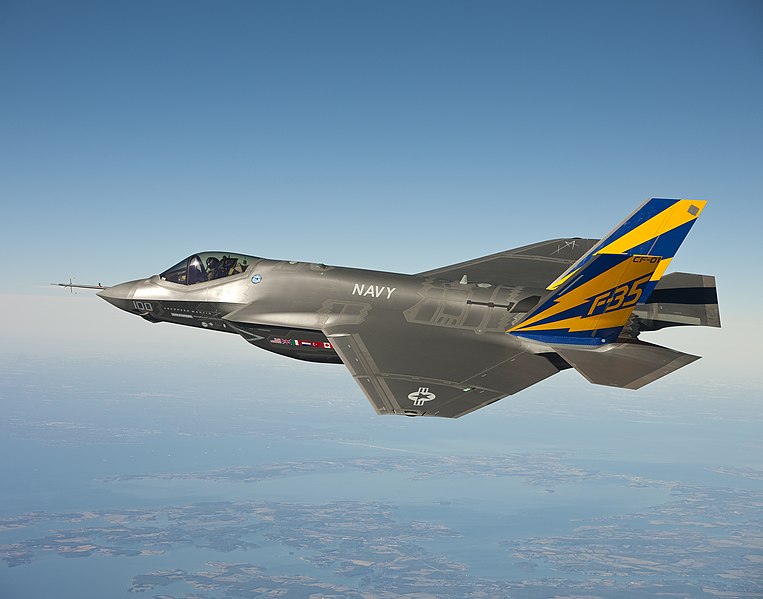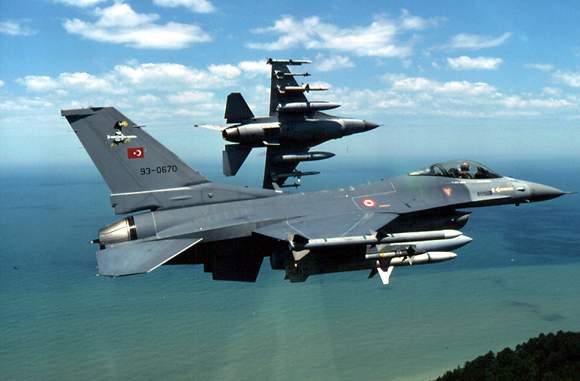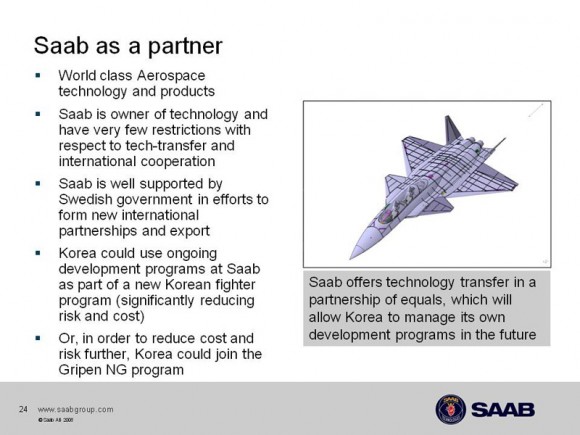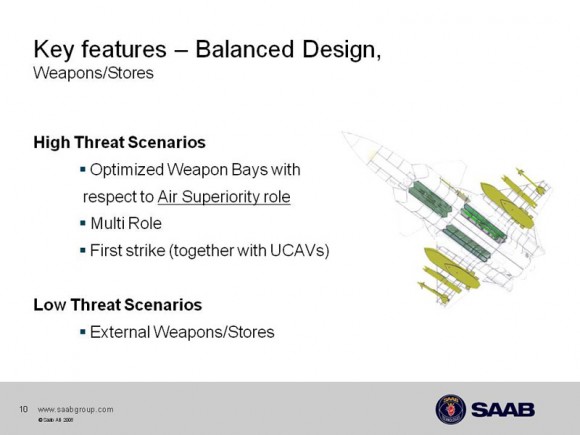Turkey holding rival talks on aircraft with Koreans, Swedes
Besides an ongoing plan to develop a fighter jet program with the US or Europe, Turkey is seeking to broaden its fleet with a second option. South Korea’s KAI and Sweden’s Saab are the two possible partners, according to a Turkish procurement official. Turkey is supposed to take part in the design of the possible project
 A Swedish Air Force JAS-39 Gripen fighter aircraft arrives at the Graf Ignatievo Air Base in Bulgaria in this file photo. Turkey is considering to design, develop and produce a new fighter plane with Sweden’s Saab. |
Turkey recently had held separate talks with aeronautical officials from South Korea and Sweden for possible cooperation in the design, development and production of a new fighter aircraft in the next decade, a senior procurement official said at the weekend.
“The companies are South Korea’s Korea Aerospace Industries [KAI] and Sweden’s Saab,” the official said.
KAI is the manufacturer of several military and civilian aircraft and satellites and is planning to produce the fighter aircraft KF-X. Saab is the maker of the multi-role fighter JAS 39 Gripen.
Turkey, whose present fighter fleet is made up of U.S.-made aircraft, also plans to buy the F-35 Joint Strike Fighter Lightning II planes, a next-generation, multinational program also led by the United States.
But Turkish officials privately say they want another future jet fighter to be developed with a country or countries other than the United States, in an effort to reduce the country’s dependence on Washington.
Most of Turkey’s present fleet of F-16 fighters, being modernized by U.S. firm Lockheed Martin, and the planned future F-35s are open to U.S. influence. Only its older F-4 aircraft, modernized by Israel, and its oldest F-16s, being modernized by Turkey itself, technologically are free from this influence, the officials said. But these older aircraft are expected to be decommissioned around 2020.
“Turkey wants part of its fighter aircraft fleet to remain outside the technological and other influence of the United States. It believes this scheme would better fit its national interests,” said one Turkish defense analyst.
So as part of efforts to select a new fighter for the Turkish Air Force, Turkish Aerospace Industries, or TAI, has been tasked with determining the specifications of the new fighter. It has until the end of next year to finish the process.
Turkey in the past has assembled and jointly manufactured some military aircraft, but this is the first time the country’s developing defense industry fully will be involved in the design of a complex weapons system, such as a jet fighter.
The country last year held an initial round of talks with South Korea’s KAI on the matter. But the South Koreans then offered only a 20 percent share of the project to Turkey, with another 20 percent going to Indonesia, opting for 60 percent of the program for themselves. Turkey wants an equal share in the development of a new plane and was quick to reject the offer.
“Now the South Koreans are coming much closer to the idea of equal ownership, and this is positive,” said the Turkish procurement official. “But there are still many more things to be discussed with them.”
In the meantime, Turkey continues to be interested in rival programs, and the recent talks with Saab officials reflect this situation, the procurement official said. “Sweden also is a potential partner for us.”
In addition to KAI and Saab, a consortium of European companies, also continues efforts to include Turkey in its program for the Eurofighter Typhoon project. This consortium is Eurofighter, whose members include Italian, German, British and Spanish firms.
Italy’s deputy defense minister said in May that the pan-European Eurofighter Typhoon fighter aircraft was the only viable alternative to U.S. planes in this category, urging Turkey to join the ambitious European-led defense program.
“The Eurofighter is the only alternative to U.S. aircraft, and provides a great relief to world countries,” Guido Crosetto said in Istanbul on the sidelines of the International Defense Industry Fair 2011.
المصدر جريدة حريات التركيه
http://www.hurriyetdailynews.com/n.php?n=lira-strengthened-first-day-in-three-as-oil-price-falls-2011-08-22
تركيا تجرى مباحثات مع شركة ساب السويديه
المصنعه للمقاتله JAS 39 Gripen

ومحادثات مع مؤسسة الصناعات الجويه الكوريه
التى تقوم بتصنيع طائرات التدريب
وتنوى تصنيع مقاتله جديده KF-X

على الرغم من أن تركيا ستحصل على المقاتله F-35 Joint Strike Fighter Lightning II
وسيكون العدد حوالى 120 مقاتله تقريبآ

إلا إنها تريد أن تقتنى مقاتله جديده تكون مشاركه فى تصنيعها
لكى تحقق الأكتفاء التكنولوجى وتخرج من العبأه الأمريكيه
التى هى تحت رحمتها حاليآ حيث أن عصب سلاح الجو التركى
مقاتلات F-16

وعلى الرغم من تجميعها بتركيا إلا إنها تحتاج لشركة لوكهيد مارتن
فى الإلكترونيات وأنظمة الكمبيوتر المهمه
ومقاتلات F-4 التى تم تطويرها فى إسرائيل


ومن المقرر خروج بعض مقاتلات الأف16 القديمه وكامل إسطول الفانتوم بحلول 2020
لذلك تركيا تريد توفير مصدر أخر لسلاح الجو غير أمريكى
وكانت تركيا تفاوضت مع كوريا من قبل على مشروع المشاركه
إلا غن الكوريين عرضو نسبة 20% لتركيا و 20% لإندونيسيا
مع إحتفاظ كوريا بنسبة 60%
إلا إن الأتراك رفضوا ذلك وطلبو المشاركه الكامله بنسبة 50% فى المشروع
ويبدو أن هناك تفاهم كورى حاليأ للمطالب التركيه
من ناحيه أخر تسعى تركيا لدخول الكونسورتيم الاوربى الذى يقوم بإنتاج المقاتله
Eurofighter

والتى تعتبر أفضل بديل حالى للمقاتلات الأمريكيه
ولن تخضع تركيا للشروط الصعبه التى تواجهها مع أمريكا
ومن المعروف أن تركيا تمتلك
246 F-16 Block 50+ CCIP
156 F-4E 2020 Terminator Striker/Bomber
هذا موضوع كنت كتبته من قبل عن جدوى مشروع هذه الطائره
http://www.defencetalk.com/indonesia...-option-35584/

“The companies are South Korea’s Korea Aerospace Industries [KAI] and Sweden’s Saab,” the official said.
KAI is the manufacturer of several military and civilian aircraft and satellites and is planning to produce the fighter aircraft KF-X. Saab is the maker of the multi-role fighter JAS 39 Gripen.
Turkey, whose present fighter fleet is made up of U.S.-made aircraft, also plans to buy the F-35 Joint Strike Fighter Lightning II planes, a next-generation, multinational program also led by the United States.
But Turkish officials privately say they want another future jet fighter to be developed with a country or countries other than the United States, in an effort to reduce the country’s dependence on Washington.
Most of Turkey’s present fleet of F-16 fighters, being modernized by U.S. firm Lockheed Martin, and the planned future F-35s are open to U.S. influence. Only its older F-4 aircraft, modernized by Israel, and its oldest F-16s, being modernized by Turkey itself, technologically are free from this influence, the officials said. But these older aircraft are expected to be decommissioned around 2020.
“Turkey wants part of its fighter aircraft fleet to remain outside the technological and other influence of the United States. It believes this scheme would better fit its national interests,” said one Turkish defense analyst.
So as part of efforts to select a new fighter for the Turkish Air Force, Turkish Aerospace Industries, or TAI, has been tasked with determining the specifications of the new fighter. It has until the end of next year to finish the process.
Turkey in the past has assembled and jointly manufactured some military aircraft, but this is the first time the country’s developing defense industry fully will be involved in the design of a complex weapons system, such as a jet fighter.
The country last year held an initial round of talks with South Korea’s KAI on the matter. But the South Koreans then offered only a 20 percent share of the project to Turkey, with another 20 percent going to Indonesia, opting for 60 percent of the program for themselves. Turkey wants an equal share in the development of a new plane and was quick to reject the offer.
“Now the South Koreans are coming much closer to the idea of equal ownership, and this is positive,” said the Turkish procurement official. “But there are still many more things to be discussed with them.”
In the meantime, Turkey continues to be interested in rival programs, and the recent talks with Saab officials reflect this situation, the procurement official said. “Sweden also is a potential partner for us.”
In addition to KAI and Saab, a consortium of European companies, also continues efforts to include Turkey in its program for the Eurofighter Typhoon project. This consortium is Eurofighter, whose members include Italian, German, British and Spanish firms.
Italy’s deputy defense minister said in May that the pan-European Eurofighter Typhoon fighter aircraft was the only viable alternative to U.S. planes in this category, urging Turkey to join the ambitious European-led defense program.
“The Eurofighter is the only alternative to U.S. aircraft, and provides a great relief to world countries,” Guido Crosetto said in Istanbul on the sidelines of the International Defense Industry Fair 2011.
المصدر جريدة حريات التركيه
http://www.hurriyetdailynews.com/n.php?n=lira-strengthened-first-day-in-three-as-oil-price-falls-2011-08-22
تركيا تجرى مباحثات مع شركة ساب السويديه
المصنعه للمقاتله JAS 39 Gripen

ومحادثات مع مؤسسة الصناعات الجويه الكوريه
التى تقوم بتصنيع طائرات التدريب
وتنوى تصنيع مقاتله جديده KF-X

على الرغم من أن تركيا ستحصل على المقاتله F-35 Joint Strike Fighter Lightning II
وسيكون العدد حوالى 120 مقاتله تقريبآ

إلا إنها تريد أن تقتنى مقاتله جديده تكون مشاركه فى تصنيعها
لكى تحقق الأكتفاء التكنولوجى وتخرج من العبأه الأمريكيه
التى هى تحت رحمتها حاليآ حيث أن عصب سلاح الجو التركى
مقاتلات F-16

وعلى الرغم من تجميعها بتركيا إلا إنها تحتاج لشركة لوكهيد مارتن
فى الإلكترونيات وأنظمة الكمبيوتر المهمه
ومقاتلات F-4 التى تم تطويرها فى إسرائيل


ومن المقرر خروج بعض مقاتلات الأف16 القديمه وكامل إسطول الفانتوم بحلول 2020
لذلك تركيا تريد توفير مصدر أخر لسلاح الجو غير أمريكى
وكانت تركيا تفاوضت مع كوريا من قبل على مشروع المشاركه
إلا غن الكوريين عرضو نسبة 20% لتركيا و 20% لإندونيسيا
مع إحتفاظ كوريا بنسبة 60%
إلا إن الأتراك رفضوا ذلك وطلبو المشاركه الكامله بنسبة 50% فى المشروع
ويبدو أن هناك تفاهم كورى حاليأ للمطالب التركيه
من ناحيه أخر تسعى تركيا لدخول الكونسورتيم الاوربى الذى يقوم بإنتاج المقاتله
Eurofighter

والتى تعتبر أفضل بديل حالى للمقاتلات الأمريكيه
ولن تخضع تركيا للشروط الصعبه التى تواجهها مع أمريكا
ومن المعروف أن تركيا تمتلك
246 F-16 Block 50+ CCIP
156 F-4E 2020 Terminator Striker/Bomber
هذا موضوع كنت كتبته من قبل عن جدوى مشروع هذه الطائره
http://www.defencetalk.com/indonesia...-option-35584/

الجميع لديه بعض المعلومات عن مشروع هذه المقاتله الكوريه التى تعد من الجيل +4
فى هذا المقال خبر قرب توقيع مذكرة تفاهم بين كوريا وإندونيسيا للمشاركه فى هذا المشروع
ويتحدث المقال عن إمكانية نجاح هذا المشروع وما هو العائد الذى سيعود على كل من اندونيسيا وكوريا
بالنسبه لإندونيسا
فأعضاء البرلمان مقتنعون إن هذا المشروع سينشط الصناعات الدفاعيه الإندونيسيه
والتى ستشارك بمبلغ 2 مليار دولار
وسيتم تصنيع خمسة نماذج خلال الثمانى سنوات القادمه
ومن المتوقع أن يتم تصنيع 200 مقاتله للبلدين
وهذا جيد بالنسبه لإندونيسيا التى تعتبر أكبر بلد مسلم فى العالم
وأيضآ هذا يدحض القول القائل بأن الدول الكبر وحدها هى التى تستطيع فقط الدخول فى مثل هذه المشاريع
ولكن هناك أسئله يجب أن تطرح قبل الإنغماس فى وجهات النظر المتفائله
منها
ما جدوى هذا المشروع لإندونيسيا
فهذا المشروع المثير للجدل بدء فى عام 2001
بتكلفه 13مليار دولار لإنتاج 120 مقاتله
ومن المعروف أن كوريا تفتقر إلى القدرات الفنيه والماليه اللازمه لتصنيع هذه المقاتله كامله
فهى تستطيع إنتاج نسبة 63% من هذه الطائره
وهى تقوم بتصنيع طائرة التدريب t50 والتى لم تستطيع بيعها إلا إلى إندونيسيا هذا العام
مع وجود أخبار عن رغبة الإمارات وإسرائيل ودول أخرى
وتقوم أيضآ بتصنيع بعض أجزاء الأف16 والأف15
أيضآ هناك الأكتفاء الذاتى من التكنولوجيا
فانظمه خاصه للمقاتله مثل الأفيونكس والمحرك ستأتى من بلدان أخرى
وهذا سيمثل ضغوط سياسيه على إندونيسيا
فكوريا تصنع طائرة التدريب بالإشتراك مع لوكهيدمارتن
وفى حالة صناعة المقاتله
من المقترح أن يتم تركيب رادار aesa إسرائيلى الصنع يجمع فى كوريا الجنوبيه
أيضآ ستحتاج كوريا إلى لوكهيد وبوينج وإيداس وساب فى توريد معدات أخرى
مما يمثل تعقيدات كثيره للمشروع
أيضآ هناك مشكلة التطوير وزيادة التكلفه
فما هى خطط تطوير هذه المقاتله التى تعتمد على عدة مصادر
وما هى إمكانية زيادة التكلفه على غرار الأف35
واليورفايتر
فهل لدى إندونيسيا المرونه لتحمل كل ذلك
أيضآ غير معروف ما هى النسبه التى ستساهم فيها الصناعات الإندونيسيه
فى تصنيع هذه المقاتله ونقل التكنولوجيا وتشغيل أيدى عامله كل هذا غير معروف
وهل ستتمكن المقاتله من المنافسه فى السوق العالميه خاصة مع المقاتلات الروسيه والصينيه
وخاصة إنها ستنتج بعد 2020
حينها سيكون هناك دول مجاوره لكوريا الجنوبيه تمتلك مقاتلات الجيل الخامس
على غرار اليابان والصين والهند وروسيا
فهل سيكون الأفضل لكوريا شراء مقاتله جيل خامس أما صناعة مقاتله وطنيه من الجيل الرابع ونصف
هذا الأمر ليس مهم لإندونيسيا لأنه لا يوجد أحد من جيرانها يسعا لإمتلاك مقاتلات جيل خامس







كان هناك أخبار عن إحتمال مشاركة تركيا فى هذا المشروع
وفى الماضى كنت أتمنا مشاركة دول عربيه فى هذا المشروع مع كوريا مع نقل التكنولوجيا
لكن بعد ما تم عرضه فى هذا المقال
ما هى الجدوى من هذا المشروع ؟
هل سيكون ذى فائده للدول المتوسطة الحال كإندونيسيا ودولنا العربيه
أما سيكون مغامره فاشله
أما إن هناك إحتمالات جيده لنجاح المشروع
والمعلومات بالأعلى يروج لها الغربيين لإجهاض مثل هذه المشاريع ويظلون مسيطرون على السوق العالميه
فى هذا المقال خبر قرب توقيع مذكرة تفاهم بين كوريا وإندونيسيا للمشاركه فى هذا المشروع
ويتحدث المقال عن إمكانية نجاح هذا المشروع وما هو العائد الذى سيعود على كل من اندونيسيا وكوريا
بالنسبه لإندونيسا
فأعضاء البرلمان مقتنعون إن هذا المشروع سينشط الصناعات الدفاعيه الإندونيسيه
والتى ستشارك بمبلغ 2 مليار دولار
وسيتم تصنيع خمسة نماذج خلال الثمانى سنوات القادمه
ومن المتوقع أن يتم تصنيع 200 مقاتله للبلدين
وهذا جيد بالنسبه لإندونيسيا التى تعتبر أكبر بلد مسلم فى العالم
وأيضآ هذا يدحض القول القائل بأن الدول الكبر وحدها هى التى تستطيع فقط الدخول فى مثل هذه المشاريع
ولكن هناك أسئله يجب أن تطرح قبل الإنغماس فى وجهات النظر المتفائله
منها
ما جدوى هذا المشروع لإندونيسيا
فهذا المشروع المثير للجدل بدء فى عام 2001
بتكلفه 13مليار دولار لإنتاج 120 مقاتله
ومن المعروف أن كوريا تفتقر إلى القدرات الفنيه والماليه اللازمه لتصنيع هذه المقاتله كامله
فهى تستطيع إنتاج نسبة 63% من هذه الطائره
وهى تقوم بتصنيع طائرة التدريب t50 والتى لم تستطيع بيعها إلا إلى إندونيسيا هذا العام
مع وجود أخبار عن رغبة الإمارات وإسرائيل ودول أخرى
وتقوم أيضآ بتصنيع بعض أجزاء الأف16 والأف15
أيضآ هناك الأكتفاء الذاتى من التكنولوجيا
فانظمه خاصه للمقاتله مثل الأفيونكس والمحرك ستأتى من بلدان أخرى
وهذا سيمثل ضغوط سياسيه على إندونيسيا
فكوريا تصنع طائرة التدريب بالإشتراك مع لوكهيدمارتن
وفى حالة صناعة المقاتله
من المقترح أن يتم تركيب رادار aesa إسرائيلى الصنع يجمع فى كوريا الجنوبيه
أيضآ ستحتاج كوريا إلى لوكهيد وبوينج وإيداس وساب فى توريد معدات أخرى
مما يمثل تعقيدات كثيره للمشروع
أيضآ هناك مشكلة التطوير وزيادة التكلفه
فما هى خطط تطوير هذه المقاتله التى تعتمد على عدة مصادر
وما هى إمكانية زيادة التكلفه على غرار الأف35
واليورفايتر
فهل لدى إندونيسيا المرونه لتحمل كل ذلك
أيضآ غير معروف ما هى النسبه التى ستساهم فيها الصناعات الإندونيسيه
فى تصنيع هذه المقاتله ونقل التكنولوجيا وتشغيل أيدى عامله كل هذا غير معروف
وهل ستتمكن المقاتله من المنافسه فى السوق العالميه خاصة مع المقاتلات الروسيه والصينيه
وخاصة إنها ستنتج بعد 2020
حينها سيكون هناك دول مجاوره لكوريا الجنوبيه تمتلك مقاتلات الجيل الخامس
على غرار اليابان والصين والهند وروسيا
فهل سيكون الأفضل لكوريا شراء مقاتله جيل خامس أما صناعة مقاتله وطنيه من الجيل الرابع ونصف
هذا الأمر ليس مهم لإندونيسيا لأنه لا يوجد أحد من جيرانها يسعا لإمتلاك مقاتلات جيل خامس







كان هناك أخبار عن إحتمال مشاركة تركيا فى هذا المشروع
وفى الماضى كنت أتمنا مشاركة دول عربيه فى هذا المشروع مع كوريا مع نقل التكنولوجيا
لكن بعد ما تم عرضه فى هذا المقال
ما هى الجدوى من هذا المشروع ؟
هل سيكون ذى فائده للدول المتوسطة الحال كإندونيسيا ودولنا العربيه
أما سيكون مغامره فاشله
أما إن هناك إحتمالات جيده لنجاح المشروع
والمعلومات بالأعلى يروج لها الغربيين لإجهاض مثل هذه المشاريع ويظلون مسيطرون على السوق العالميه
